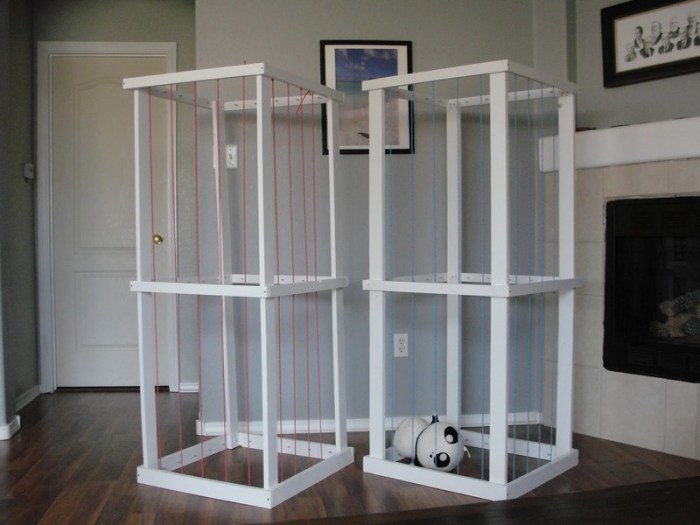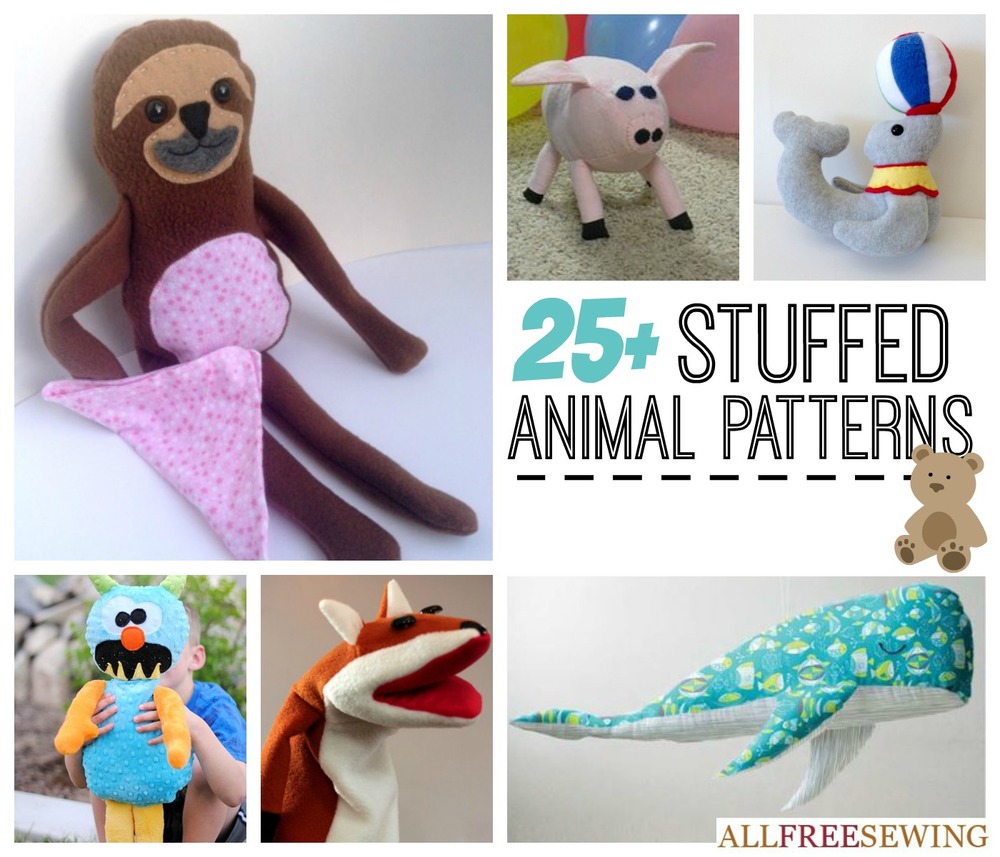DIY Stuffed Animal Zoo: Imagine a world where cuddly creatures come to life, each one a unique creation from your own imagination. Building a DIY stuffed animal zoo is an engaging activity that sparks creativity, ignites imagination, and offers a delightful way to bring the animal kingdom into your home. It’s a journey that invites you to become a zookeeper, crafting your own menagerie of charming stuffed animals, each with its own personality and story to tell.
This project is perfect for both children and adults, offering a fun and educational experience. You can learn basic sewing techniques, explore the world of animal design, and develop your storytelling skills. The process itself is a wonderful opportunity to bond with loved ones, sharing the joy of crafting and creating together.
Basic Stuffed Animal Construction Techniques

Creating your own stuffed animals is a rewarding and enjoyable craft. You can bring your imagination to life and create unique and personalized companions. This section will guide you through the essential steps of constructing a stuffed animal, from cutting patterns to stuffing the finished product.
Cutting Patterns
Cutting patterns accurately is crucial for a well-proportioned stuffed animal. It ensures that all the pieces fit together seamlessly. Here are some tips for cutting patterns:
- Use sharp fabric scissors to ensure clean cuts. Dull scissors can fray the fabric and make it difficult to stitch.
- Place the pattern pieces on the fabric, making sure the grain lines match. This ensures that the fabric stretches evenly and the finished product looks consistent.
- Pin the pattern pieces to the fabric to prevent them from shifting while you cut. Use plenty of pins to secure the pattern.
- Cut around the pattern pieces carefully, leaving a seam allowance of about 1/4 inch. This will allow you to sew the pieces together without the fabric being too tight.
Designing and Creating Animal Characters
Bringing your stuffed animal zoo to life involves creating a diverse cast of characters. This section explores how to design and craft unique and engaging animal characters, drawing inspiration from real-life animals, mythical creatures, and beloved cartoon characters.
Translating Animal Features into Stuffed Animal Designs
Translating animal features into stuffed animal designs requires careful consideration of proportions, details, and expressions. By understanding these key elements, you can create realistic or stylized animal characters that capture their essence.
Proportions
The proportions of an animal are crucial for creating a recognizable and believable design. For example, a giraffe’s long neck and legs are essential to its silhouette.
The key to successful animal design is capturing the essence of the creature, not just replicating its exact appearance.
Details
Adding details can enhance the realism and personality of your stuffed animal. For instance, a lion’s mane, a zebra’s stripes, or a bird’s feathers can bring your character to life.
Expressions
Facial expressions play a significant role in conveying the personality and emotions of your stuffed animal. Consider the shape of the eyes, the placement of the mouth, and the overall expression of the face.
Displaying and Arranging Your Zoo: Diy Stuffed Animal Zoo
Now that you have a collection of adorable stuffed animals, it’s time to give them a home! Displaying your zoo in a visually appealing and engaging way can bring your creations to life and provide hours of entertainment for both you and visitors.
This section will explore different methods for displaying your stuffed animal zoo, including using shelves, tables, or even a dedicated play area. We will also discuss how to create a sense of depth and realism by arranging animals in different positions and groupings.
Using Shelves for Display
Shelves offer a versatile and practical solution for displaying your stuffed animal zoo. They provide ample space for showcasing your creations, and you can easily customize the arrangement to create different themes or habitats.
Here are some tips for using shelves to display your stuffed animal zoo:
- Choose shelves that are appropriate for the size of your animals. You’ll want to make sure that the shelves are sturdy enough to support the weight of your stuffed animals and that the spacing between the shelves is adequate for your tallest creations.
- Consider the height of the shelves. If you have young children who will be interacting with the zoo, you may want to choose shelves that are low to the ground. For adults, you can opt for taller shelves that allow for a more expansive display.
- Group animals by habitat or theme. This will create a sense of organization and help visitors to easily navigate your zoo. For example, you could have a shelf dedicated to jungle animals, another to farm animals, and so on.
- Use different levels and heights to create visual interest. You can arrange your animals in different positions on the shelves, with some standing, others sitting, and some lying down. This will add depth and dimension to your display.
- Add accessories to enhance the display. You can use items like small plants, rocks, or toy trees to create a more realistic and engaging environment for your animals.
Using Tables for Display
Tables provide a flexible and adaptable surface for showcasing your stuffed animal zoo. You can use a single table or multiple tables to create a larger display area.
Here are some tips for using tables to display your stuffed animal zoo:
- Choose tables that are the right size for your collection. You’ll want to make sure that the tables are large enough to accommodate all of your animals and that they are sturdy enough to support their weight.
- Use tablecloths or runners to add a decorative touch. This can help to create a more cohesive and visually appealing display.
- Arrange animals in groups or scenes. This will help to create a sense of narrative and storytelling in your zoo.
- Incorporate different textures and materials. For example, you could use a plush rug for a grassy area, a wooden plank for a path, or a fabric backdrop for a forest scene.
- Add lighting to enhance the display. You can use lamps, spotlights, or even fairy lights to create a warm and inviting atmosphere.
Creating a Dedicated Play Area
If you have the space, creating a dedicated play area for your stuffed animal zoo can be a fun and interactive way to display your creations. This can be a room, a corner of a room, or even a play tent.
Here are some tips for creating a dedicated play area for your stuffed animal zoo:
- Choose a space that is safe and comfortable for children. You’ll want to make sure that the area is well-lit and that there are no sharp edges or other potential hazards.
- Create different zones or habitats within the play area. For example, you could have a jungle zone, a farm zone, or a desert zone. This will help to keep the play area organized and interesting for children.
- Add furniture and accessories to create a realistic and engaging environment. You can use items like playhouses, toy trees, and small animals to enhance the play area.
- Encourage children to interact with the zoo. This could include playing games, telling stories, or simply exploring the different habitats.
Creating a Sense of Depth and Realism
One of the best ways to make your stuffed animal zoo truly captivating is to create a sense of depth and realism in your display. You can achieve this by arranging animals in different positions and groupings.
Here are some tips for creating a sense of depth and realism:
- Use a variety of poses and positions. You can have some animals standing, some sitting, some lying down, and some even in mid-air. This will create a dynamic and engaging display.
- Group animals together in natural-looking scenes. For example, you could have a group of lions lounging in a grassy area or a family of elephants walking through a forest. This will help to create a sense of storytelling in your zoo.
- Use props and accessories to create depth and dimension. For example, you could use a toy tree to create a sense of height or a rock to create a sense of ground cover.
- Use lighting to highlight different areas of your display. This will help to create a sense of depth and dimension and will also draw attention to specific animals or scenes.
Sharing Your Zoo with Others

Your DIY stuffed animal zoo is a testament to your creativity and passion. Sharing it with others allows you to inspire and connect with a wider audience. It’s a chance to spread joy, spark imagination, and maybe even encourage others to embark on their own creative journeys.
Sharing Your Zoo Online
Sharing your zoo online is a great way to reach a large audience and connect with other animal lovers.
- Photo Sharing: Platforms like Instagram and Facebook are perfect for showcasing your zoo’s unique charm. Use captivating photos that highlight the details of your creations, their personalities, and the overall atmosphere of your zoo.
- Video Sharing: YouTube and TikTok offer opportunities to share engaging videos. Consider creating a “zoo tour” video, showcasing your construction process, or demonstrating fun activities you can do with your stuffed animals.
- Blog or Website: A blog or website allows you to share a more in-depth look at your zoo. You can document your creative process, share tips and tricks, and even offer tutorials for others to create their own stuffed animal companions.
Hosting an Exhibition
Sharing your zoo through an exhibition is a wonderful way to engage with people in person.
- Local Libraries or Community Centers: These venues often host community events and are welcoming to creative projects. Contact them to inquire about potential exhibition opportunities.
- Schools or Daycare Centers: Children are particularly fascinated by stuffed animals, making these locations ideal for showcasing your zoo. Consider organizing a “Meet the Animals” event, where children can interact with your creations.
- Art Galleries or Craft Fairs: These venues provide a platform for showcasing your artistry and connecting with a wider audience. Check local listings for upcoming events and consider submitting your zoo for consideration.
Tips for Effective Showcasing, Diy stuffed animal zoo
- Visually Appealing Displays: Create eye-catching displays that highlight the unique personalities of your stuffed animals. Use different textures, colors, and backgrounds to add depth and visual interest.
- Informative Labels: Provide labels with information about each animal, including its name, species, and any interesting facts. This adds educational value to your exhibition and helps engage visitors.
- Interactive Elements: Consider incorporating interactive elements to enhance the visitor experience. This could include a “guess the animal” game, a “make your own stuffed animal” activity, or a “build your own zoo” station.
Creating a DIY stuffed animal zoo is a journey of imagination and creativity. As you bring your furry, feathered, and scaly friends to life, you’ll discover a world of endless possibilities. Whether you’re sharing your zoo with others or simply enjoying its whimsical charm in your own space, the experience will be a rewarding one. So, gather your materials, unleash your imagination, and let the adventure begin!
A DIY stuffed animal zoo is a fun project for kids of all ages, and it can be as simple or as elaborate as you like. You can use old stuffed animals, or even create your own from scratch. For a festive touch, consider incorporating elements from a DIY outdoor manger scene , such as miniature farm animals or a small stable.
Your stuffed animal zoo will be a delightful addition to any playroom or bedroom, bringing joy and imagination to life.
